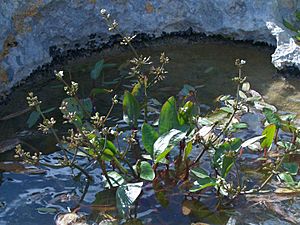Damasonium alisma facts for kids
Quick facts for kids Starfruit |
|
|---|---|
 |
|
| Conservation status | |
| Scientific classification | |
| Genus: |
Damasonium
|
| Species: |
alisma
|
| Synonyms | |
|
|
The Damasonium alisma is a special kind of flowering marsh plant. It is often called starfruit because of its unique shape. This plant naturally grows in several countries. You can find it in parts of Great Britain, France, Portugal, Spain, Italy, Greece, Russia, Ukraine, Moldova, and Kazakhstan.
Starfruit is native to the British Isles. It used to be very common in southern and central England. However, its numbers have dropped a lot. This is mainly because many of the ponds where it lives have disappeared. In 2006, it was not seen growing wild in the United Kingdom. Because of this, it is now listed as an endangered species there. Good news though! Seeds from a population that had disappeared were planted in ponds in 2013. These plants have been growing successfully each year since then.
Contents
What is the Starfruit Plant?
The starfruit plant, Damasonium alisma, is a type of aquatic plant. This means it grows in water. It prefers to live in ponds that have acidic water.
Where Does Starfruit Grow?
In Great Britain, the starfruit plant became rare as many village ponds disappeared. It once grew in many English counties, from Sussex in the south up to Shropshire. But by 1900, it was only found in a few ponds. Luckily, it is slowly making a comeback. This is thanks to a lot of hard work by conservation groups.
What Does Starfruit Need to Grow?
For starfruit to grow well, it needs certain conditions. It likes open, sunny, and shallow water. Its seeds also need mud that gets stirred up regularly to sprout.
How Was Starfruit Named?
The starfruit plant was first described by a famous scientist named Carl Linnaeus. He named it Alisma damasonium in 1753. Later, in 1768, another scientist named Philip Miller moved it to its own group, or genus, called Damasonium. That's how it got its current scientific name, Damasonium alisma.
See also
 In Spanish: Azúmbar para niños
In Spanish: Azúmbar para niños


